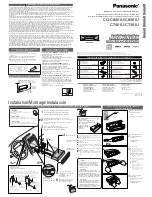
60
the same distance from the main listening area as the Left and
Right speakers.
■
If THX-certified LCR speakers are used and must be either above
or below ear level when seated, aim them down (or up) into the
listening area. They are intentionally quite directional in the vertical
plane, to improve dialog intelligibility and localization.
■
Placing the LCRs below the screen is generally preferable to place-
ment above.
■
The subwoofers do not have to be extremely close to the LCRs—
anywhere in the room is all right, but placement will affect the
consistency of the low bass. Experimentation is in order.
■
Dipolar surrounds should be located high and to the sides of the
listeners instead of behind them, in order to place the audience in
the surround speakers’ null. If the viewing area is more than one
row deep, place the surrounds halfway back within the seating
area.
■
If architectural constraints prevent ideal placement of dipolar sur-
rounds directly to the sides of the listening area, it is generally best
to err on the side of being a bit further to the rear of the room.
■
When using traditional speakers for the surround channels, the
speakers should be located high and somewhat behind the listen-
ers, with the speakers’ output directed toward the rear wall rather
than at the listeners.
■
The surrounds should be relatively high, often near the ceiling for
the best results. And they should be located equally distant from
their adjacent walls/ceilings, or else one will have more mid-bass
than the other.
additional notes on
speaker placement
• Some allowance must be made for those installations involving
relatively small screens, such as 35" direct-view televisions. Placing
the speakers immediately beside televisions of this size may reduce
the stereo separation to unacceptable levels. Some experimentation
is in order, but as a rule of thumb, try to have the L and R speakers
spread apart by no more than approximately 1.5 times the width of
the screen to avoid cognitive dissonance from the apparent conflict
between visual and aural images.
• With regard to subwoofer placement, it is important to leave your-
self some leeway during final installation for minor movements to
minimize room modes. Corner placement usually works best, but
not always—you have to try it in your particular situation to be
sure.
• Use multiple subwoofers if more bass output is needed. This also
has the advantage of allowing one subwoofer to fill the other’s
“holes” created by room modes, while reducing distortion by giving
each subwoofer an easier task.
Summary of Contents for Digital Surround Decoder
Page 1: ...PR O C E E D Digital Surround Decoder...
Page 82: ...82 Installation Notes...
Page 83: ...83...
Page 84: ...84...
Page 85: ...85...
Page 86: ...86...
Page 87: ...87...
Page 88: ...88...
Page 89: ...89...















































